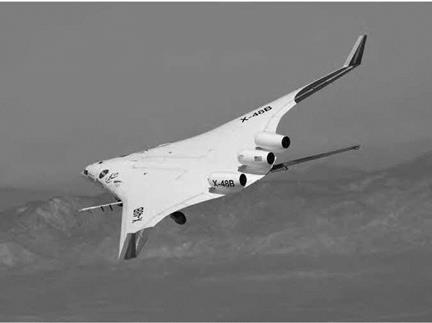Final Maturity: Concept Demonstrators
The efforts of the NACA and NASA in developing and applying dynamically scaled free-flight model testing techniques have progressed through a truly impressive maturation process. Although the scaling relationships have remained constant since the inception of free-flight testing, the facilities and test attributes have become dramatically more sophisticated. The size and construction of models have changed from unpowered balsa models weighing a few ounces with wingspans of less than 2 feet to very large powered composite models with weights of over 1,000 pounds. Control systems have changed from simple solenoid bang-bang controls operated by a pilot with visual cues provided by model motions to hydraulic systems with digital flight controls and full feedbacks from an array of sensors and adaptive control systems. The level of sophistication integrated into the model testing techniques has now given rise
|
The Boeing X-48B Blended Wing-Body flying model in flight at NASA Dryden. The configuration has undergone almost 15 years of research, including free-flight testing at Langley and Dryden. NASA. |
to a new class of free-flight models that are considered to be integrated concept demonstrators rather than specific technology tools. Thus, the lines between free-flight models and more complex remotely piloted vehicles have become blurred, with a noticeable degree of refinement in the concept demonstrators.
Research activities at the NASA Dryden Flight Research Center vividly illustrate how far free-flight testing has come. Since the 1970s, Dryden has continually conducted a broad program of demonstrator applications with emphasis on integrations of advanced technology. In 1997, another milestone was achieved at Dryden in remotely piloted research vehicle technology, when an X-36 vehicle demonstrated the feasibility of using advanced technologies to ensure satisfactory flying qualities for radical tailless fighter designs. The X-36 was designed as a joint effort between the NASA Ames Research Center and the Boeing Phantom Works (previously McDonnell-Douglas) as a 0.28-scale powered free-flight model of an advanced fighter without vertical or horizontal tails to enhance survivability. Powered by a F112 turbofan engine and weighing about 1,200 pounds, the 18-foot-long configuration used
a canard, split aileron surfaces, wing leading – and trailing-edge flaps, and a thrust-vectoring nozzle for control. A single-channel digital flyby-wire system provided artificial stability for the configuration, which was inherently unstable about the pitch and yaw axes.[505]











